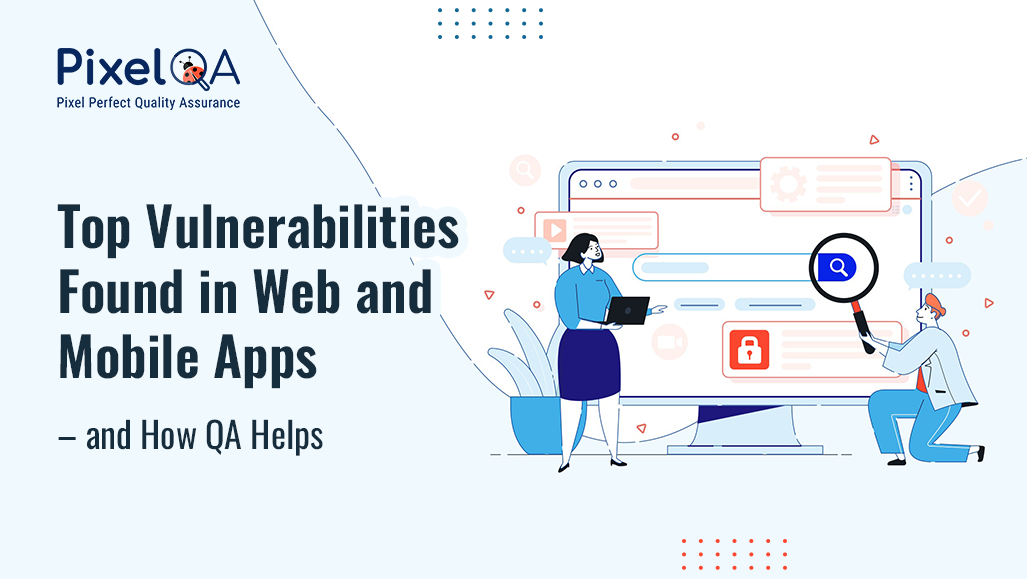
What if your front door also happened to be your biggest point of vulnerability For todays organizations that door is their mobile and web applications The critical pathways to ecommerce banking healthcare and customer interactions And yet those very applications frequently contain embedded vulnerabilities silently putting sensitive data revenues and brand reputation at risk
A single vulnerability can expose customer information invite cyberattacks or result in catastrophic downtime The prices are catastrophic data breaches cost firms millions and users lose trust at once with insecure or buggy apps For business decision makers the burning question is not developing apps that work but developing them securely reliably and resiliently from the ground up That is where Quality Assurance QA and choosing the right Security Testing Partner fit in
Let us explore the most critical weaknesses found in web and mobile applications and learn how a strong QA process helps reduce them before they become business disasters
1. Weak Authentication and Authorization
The Risk
Weak authentication mechanisms grant access to resources for illegitimate users Similarly weak authorization policies grant privileges to users to perform actions or view data they should not
How QA Helps
QA engineers perform penetration testing Secure coding standards are enforced and role based access controls are validated QA engineers mimic real world attack vectors so login controls and access permissions are more secure and regulatory compliant for GDPR or HIPAA
2. Insecure Data Storage
The Risk
Mobile apps often store sensitive data locally while web apps may not have properly encrypted databases Unencrypted storage puts customer credentials payment information or business critical information at risk of theft or system compromise
How QA Helps
By security testing QA ensures data is encrypted both in transit and at rest They follow data protection regulations and look for vulnerabilities such as SQL injection or uncontrolled API calls that can leak information This keeps important assets safe and gives customers confidence
3. Unprotected APIs
The Risk
APIs underpin todays apps but if not secured correctly they are an open invitation to attackers Typical issues include weak authentication extremely exposed endpoints and broken input validation These can result in data exposure or denial of service attacks
How QA Helps
QA engineers conduct API testing to detect endpoint mistakes Test request response handling and verify rate limiting By stress testing APIs with heavy loads QA ensures security and stability avoiding bottlenecks and breaches
4. Cross-Site Scripting XSS and Injection Attacks
The Risk
Web applications are highly susceptible to XSS and SQL injection attacks Where an attacker injects malicious code into forms URLs or queries it can be used to steal data hijack a user session or grant admin rights to the attacker
How QA Helps
With security related test cases QA developers detect improper input sanitization early They check if user input is handled securely perform automated scan tools and adhere to secure coding that prevents these vulnerabilities from being released
5. Poor Session Management
The Risk
Sessions that are misconfigured such as never expiring tokens upon logout or using guessed session IDs expose apps to hijacking attacks A hacker can impersonate valid users and exploit their privileges
How QA Helps
QA testing includes checks for session expiry token and timeout management They ensure sessions are encrypted closed safely and hijack resistant This helps achieve a convenience privacy balance while enforcing strict security protocols
6. Insufficient Input Validation
The Risk
Unsainted or unvalidated input provides attackers with possibilities for entering malicious code crashing the system or causing other damage
How QA Helps
QA teams create negative test cases to check application boundaries by entering malformed or malicious data This initial testing exposes weaknesses and enforces validation rules making apps secure against real abuse
7. Lack of Secure Updates and Patching
The Risk
Many applications lack up to date patching or secure updating and open vulnerabilities remain unpatched Exploiters take advantage of outdated third party components or libraries and the whole system can be compromised
How QA Helps
QA testing of the update process ensures patches are securely installed without impacting functionality Continuous testing helps organizations maintain security hygiene and lessens exposure to new threats
The Business Case for QA in Security
Ignoring vulnerabilities is not just a technical error it is a business risk The impact of app vulnerabilities includes
- Financial Losses Security incidents and downtime can cost millions in damages and lost business
- Damage to Reputation Customer trust is fragile and a single security failure can drive users to competitors
- Penalties from Regulations Noncompliance with data protection regulations can lead to fines and lawsuits
A forward looking QA strategy prevents such risks Organizations make their apps not only functional but also robust against modern threats by incorporating security into the test life cycle
Conclusion
In a world where customers demand safe frustration free digital interactions vulnerabilities are a risk businesses cannot take Every untested vulnerability contributes to the attack surface for cyberattacks compliance breaches and lost customer confidence But with end to end QA practices that extend from penetration testing to compliance scanning businesses can turn their vulnerabilities into strengths
The message could not be clearer QA investment is not about quality alone It is about safeguarding your business future By embracing QA as a strategic imperative with a trusted partner like PixelQA business leaders can ship apps with confidence that customers will trust competitors will envy and regulators will approve

